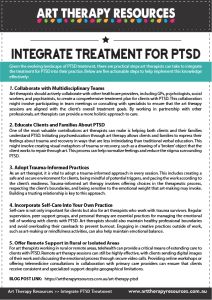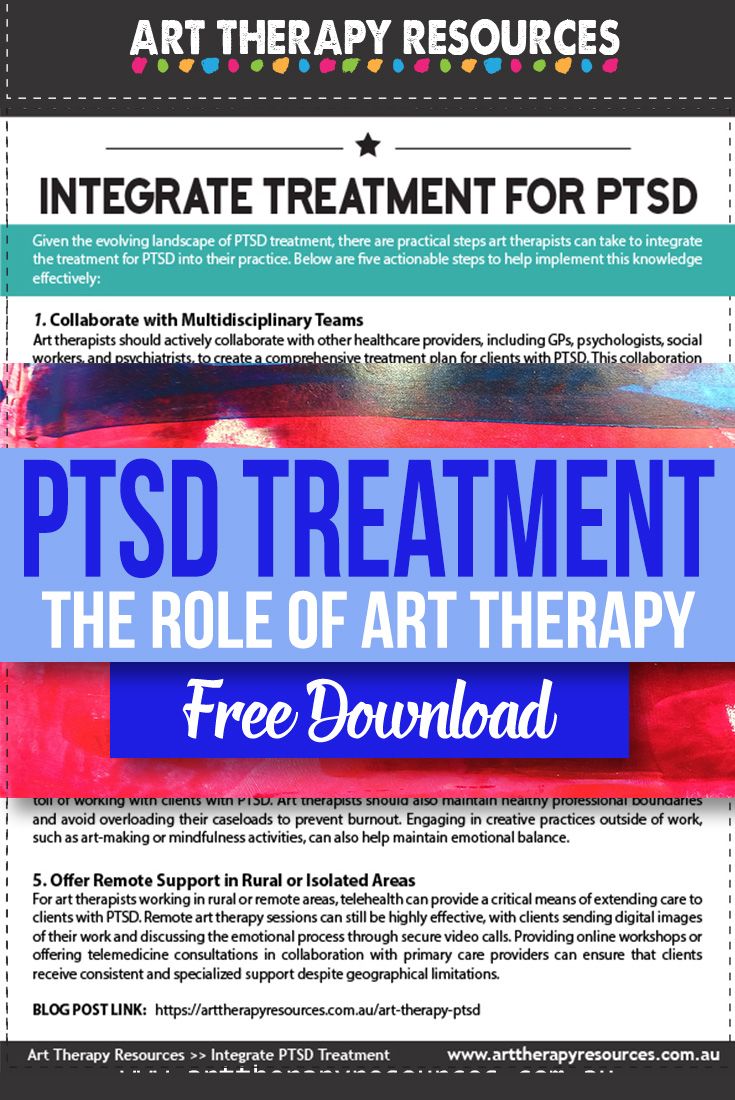THIS POST INCLUDES:
1. Involvement in Treatment in PTSD
2. Self-care for Practitioners
3. Actionable Steps for Art Therapists
4. Free Download Actionable Steps for Art Therapists
INVOLVEMENT IN TREATMENT IN PTSD
Post-Traumatic Stress Disorder (PTSD) is a complex and challenging condition that impacts not only the individual experiencing it but also their loved ones and caregivers. Art therapists play an integral role in the holistic treatment of PTSD, helping individuals express and process their trauma in creative and non-verbal ways. However, effective treatment requires collaboration and coordination with other healthcare providers, particularly when working with families and other mental health professionals.
Involving Family and Partners in the Treatment Process
While research into the impact of family involvement in PTSD treatment remains limited, clinical experience and best practice guidelines suggest that involving family members, particularly partners, can significantly benefit the recovery process. However, this must be done with care and respect for the individual’s needs and boundaries. Partners, when educated about PTSD, can serve as invaluable sources of support and encouragement. They are not expected to act as co-therapists but can provide emotional stability and assist with managing daily life stresses.
Art therapists can facilitate this process by inviting the partner to participate in early sessions, where the role of the partner can be clarified. This approach helps set appropriate boundaries and expectations, ensuring that the partner’s role is one of support rather than intervention. The inclusion of partners should be guided by the client’s preferences, always respecting their wishes to participate or not.
Good practice recommends that family members can be involved in both education and treatment planning. This collaboration fosters understanding and ensures that the needs of both the individual with PTSD and their family members are adequately addressed. In cases where the partner or family member requires mental health support themselves, referrals to appropriate services should be considered.
The Multidisciplinary Approach to PTSD Care
PTSD treatment can involve various qualified professionals working together to address the diverse needs of the individual. While psychiatrists and psychologists may take the lead in delivering symptom-focused interventions, other professionals such as occupational therapists, rehabilitation counselors, and social workers focus on broader recovery goals, such as reintegration into daily life and addressing social and occupational challenges.
The general practitioner (GP) is often at the center of this network, providing continuity of care and making necessary referrals to specialists. In rural and remote settings where access to specialists is limited, GPs may be the primary point of contact for care, offering support, conducting screenings, and providing basic psychological interventions. In such settings, art therapists can collaborate with GPs and other healthcare providers to ensure the therapeutic needs of the client are met, even if specialized interventions cannot be immediately accessed.
SELF-CARE FOR PRACTITIONERS
Working with individuals who have experienced trauma can have significant emotional and psychological impacts on the therapist. Art therapists, like all professionals working with PTSD, are at risk of developing compassion fatigue which can lead to burnout, emotional exhaustion, and a decline in clinical efficacy. It is essential for art therapists to maintain a healthy work-life balance, establish emotional boundaries with clients, and engage in regular supervision to ensure their well-being.
Special attention must be given to practitioners working in isolated or rural settings, where support and resources may be scarce. Online resources, peer support networks, and remote training opportunities can provide necessary support for these practitioners.
In addition to self-care, the broader organization or employer should foster policies that prioritize the mental health of therapists. Ensuring that art therapists have access to ongoing professional development, peer support, and appropriate training can help mitigate the negative effects of compassion fatigue and enhance the quality of care they provide.
Art therapy plays a significant role in the treatment of PTSD, offering individuals a creative outlet to process and express their trauma. However, effective treatment requires collaboration with other healthcare providers, including family members, GPs, psychologists, and psychiatrists. By fostering a holistic, multidisciplinary approach, and ensuring that practitioners maintain a strong focus on self-care, we can provide the most effective support for those living with PTSD. Art therapists, working alongside other professionals, can help facilitate meaningful recovery, creating a supportive environment where healing can occur.
ACTIONABLE STEPS FOR ART THERAPISTS
Things to Do: Steps for Art Therapists to Implement New Information in Practice
Given the evolving landscape of PTSD treatment, there are practical steps art therapists can take to integrate the treatment for PTSD into their practice.
Below are five actionable steps to help implement this knowledge effectively:
1. Collaborate with Multidisciplinary Teams
Art therapists should actively collaborate with other healthcare providers, including GPs, psychologists, social workers, and psychiatrists, to create a comprehensive treatment plan for clients with PTSD. This collaboration might involve participating in team meetings or consulting with specialists to ensure that the art therapy sessions are aligned with the client’s overall treatment goals. By working in partnership with other professionals, art therapists can provide a more holistic approach to care.
2. Educate Clients and Families About PTSD
One of the most valuable contributions art therapists can make is helping both clients and their families understand PTSD. Initiating psychoeducation through art therapy allows clients and families to express their feelings about trauma and recovery in ways that are less intimidating than traditional verbal education. This might involve creating visual metaphors of trauma or recovery, such as a drawing of a ‘broken’ object that the client works to repair through art. This process can help normalize feelings and reduce the stigma surrounding PTSD.
3. Adopt Trauma-Informed Practices
As an art therapist, it is vital to adopt a trauma-informed approach in every session. This includes creating a safe and secure environment for clients, being mindful of potential triggers, and pacing the work according to the client’s readiness. Trauma-informed art therapy involves offering choices in the therapeutic process, respecting the client’s boundaries, and being sensitive to the emotional weight that art-making may invoke. Building a trusting relationship is key to this approach.
4. Incorporate Self-Care Into Your Own Practice
Self-care is not only important for clients but also for art therapists who work with trauma survivors. Regular supervision, peer support groups, and personal therapy are essential practices for managing the emotional toll of working with clients with PTSD. Art therapists should also maintain healthy professional boundaries and avoid overloading their caseloads to prevent burnout. Engaging in creative practices outside of work, such as art-making or mindfulness activities, can also help maintain emotional balance.
5. Offer Remote Support in Rural or Isolated Areas
For art therapists working in rural or remote areas, telehealth can provide a critical means of extending care to clients with PTSD. Remote art therapy sessions can still be highly effective, with clients sending digital images of their work and discussing the emotional process through secure video calls. Providing online workshops or offering telemedicine consultations in collaboration with primary care providers can ensure that clients receive consistent and specialized support despite geographical limitations.
FREE DOWNLOAD: Art Therapy Exercise
SIGN UP below to gain access to our RESOURCE LIBRARY and download the FREE Steps for Art Therapists to do to implement new information in practice.

BUILD YOUR ART THERAPY REFERENCE MATERIALS:
Pin this image to your Pinterest board.

SHARE KNOWLEDGE & PASS IT ON:
If you’ve enjoyed this post, please share it on Facebook, Twitter, Pinterest. Thank you!
